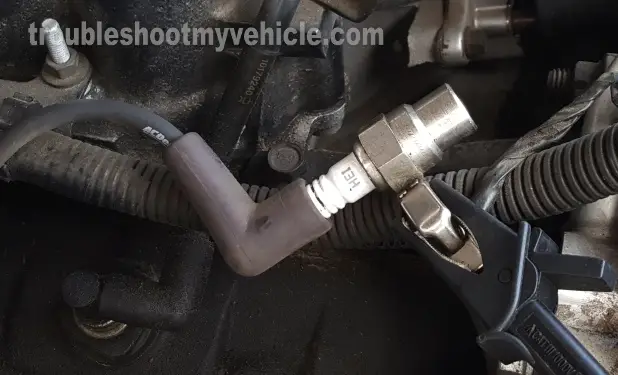Checking For Spark With A Spark Tester

Once I had identified the misfiring cylinder (#1) with the cylinder balance test, the next step was to make sure the ignition system components that feed this cylinder with spark were OK.
Specifically, I want to make sure that the spark plug wire and the distributor cap are good and transmitting the spark the ignition coil is creating. It's common for one single spark plug wire or a single tower on the distributor cap to stop working (which means they stop transmitting spark).
So, the very first thing to do was to test for spark with a spark tester at the spark plug wire. This is what I did:
- Removed the spark plug wire from the #1 spark plug.
- Attached the spark tester to the spark plug wire.
- Grounded the spark tester with a battery jump start cable directly on the battery negative (-) terminal.
- Had my neighbor crank the engine while I observed the spark tester.
The result was: I had spark! This meant I could eliminate both the spark plug wire and the distributor cap as the source of the problem.
Testing for spark with a spark tester is a critical test. I've seen most folks do one of two things: use an old spark plug or simply pull on the spark plug wire (while the engine is running) to see if they can see/hear spark.
These two methods need to be avoided since they don't provide an accurate test result and method two (pulling on the spark plug wire) can damage the ignition coil.
The Compression Test Verifies The Root Cause Of The Rough Idle
So far, in my testing, I had done several tests and these tests enabled me to make certain conclusions:
- Checked for diagnostic trouble codes (DTCs).
- None found.
- Did a cylinder balance test.
- Identified cylinder #1 as 'dead' and the source of the misfire condition.
- Checked for spark with a spark tester.
- Eliminated the spark plug wire and distributor cap as bad.
The next step was to test engine compression, to see if cylinder #1 had lower than normal compression.
Now, I won't go into the specifics of how to do an engine compression test cause I've already written a step-by-step tutorial on it and you can find it here:
But, I will tell you what my compression test results were:
- Cyl #1 120 PSI.
- Cyl #2 155 PSI.
- Cyl #3 150 PSI.
- Cyl #4 155 PSI.
- Cyl #5 160 PSI.
- Cyl #6 165 PSI.
Now, according to the rule of thumb (that engine compression should not vary more than 15% of the highest compression value), 140 PSI was the lowest compression value I could have in cylinder #1 and it was at 120 PSI.
My neighbor now knew that nothing short of an engine overhaul would solve the rough idle/misfire condition he was experiencing only at idle (after all, the engine had 220,000 miles on it!).
I had spent about an hour doing the different tests and I was ready to head back inside and cool down with a nice cold beer!
Additional Resources To Help You Troubleshoot A Misfire Condition
I hope this case study/tutorial helped you see what are some of the techniques used to trace down a hard to troubleshoot misfire condition (whether it leaves diagnostic trouble codes or not). The moral of the story, is to emphasize the importance of finding the 'dead' cylinder first (be it by a specific misfire code or a manual cylinder balance test).
Once you have found the misfiring cylinder or cylinders, you need to first, eliminate the ignition system by testing for spark with a spark tester. The next step is to check the engine compression of those misfiring cylinders, not to mention a fuel pressure leak down test!
From personal experience (20 years worth) I can tell you that one of the most important testing techniques we all should know (home and professional mechanics), is how to do a manual cylinder balance test on a car or pickup equipped with a distributor-type ignition system.
Here are a few other tutorials I've written and may come in handy.
- How To Diagnose Misfire Codes (GM 4.3L, 5.0L, 5.7L).
- How To Test The Engine Compression Test (GM 4.3L, 5.0L, 5.7L).
- How To Test The 'Spider' Fuel Injector Assembly (4.3L, 5.0L, 5.7L).
- How To Test A Misfire / No Spark-No Start Condition (GM 4.3L, 5.0L, 5.7L 96-04) (at: easyautodiagnostics.com).
- How To Test The GM Distributor Mounted Ignition Module (at: easyautodiagnostics.com).

If this info saved the day, buy me a beer!

